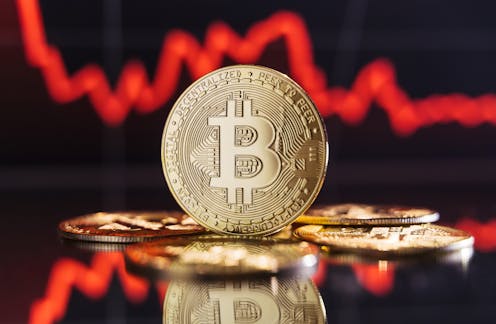Crypto was once touted as a ‘safe haven’ asset – why did it crash too this week?
- Written by Marta Khomyn, Lecturer, Finance and Data Analytics, University of Adelaide

We’ve just seen how quickly market turbulence can spread across the world of finance.
At the start of the week, fears of a US recession and a Japanese interest rate hike sent shockwaves across equity markets, currency markets (also known as forex markets) and bond markets.
The Dow Jones Industrial Average – an index that tracks a range of US shares – fell[1] by more than 1,000 points.
Japan’s stock market suffered its worst fall in 37 years.
But amid all the chaos, some of the largest losses accrued to one of the most volatile of markets – cryptocurrencies. Bitcoin fell[2] by 15% in just 24 hours, and Ethereum by 22%.
Many global markets – including crypto[3] – have now rebounded somewhat[4] since the crash. Whether we’re out of the woods yet remains unclear[5].
But why is it that seemingly unrelated assets, such as stocks and crypto, seem to crash at the same time? And what does it mean for attempts to diversify risk?
Read more: Fear gripped global markets this week – but was it all overblown?[6]
Why did markets tumble in the first place?
Much of the dip we saw in US markets at the start of the week was driven by two things: a weaker-than-expected US job market, and missed earnings forecasts[7] for a few large US tech stocks.
These factors led US investors to reassess their projections of future cash flows and triggered a selloff in equity markets, especially tech and AI-related sectors.
Globally, we also saw an unexpected interest rate hike[9] by the Bank of Japan against the backdrop of a looming expected rate cut in the United States.
This made what’s called the “carry trade[10]” – borrowing in Japanese yen (the low interest rate currency) and lending in US dollars (or other higher-interest-rate currencies) – far less profitable, prompting hedge fund investors to unwind their positions.
In crypto markets, investors are used to sharp price fluctuations. Crypto volatility is typically an order of magnitude greater than that of traditional asset classes like stocks. But the single day drop in Bitcoin’s price was large, even by crypto standards.
Why do prices move together?
US tech sector investors are in a seemingly different corner of the financial world from the hedge funds engaging in the Japanese yen carry trade. And crypto investors sometimes seem like they are in a different investment universe altogether.
But in financial markets, the “butterfly effect” – the idea that seemingly small events can have big consequences – is the rule, rather than the exception.
One reason is that large investors who lose money in one market often need cash quickly, which they get by selling in other markets.
For example, traders might get “margin calls” on their positions. In simple terms, this means they are forced to come up with cash to cover a losing “bet” on which way a stock price will move.
They may have to sell other assets in their portfolio to raise funds quickly. When multiple other assets get sold at the same time, prices go down in tandem.
But you have to move serious amounts of money to have this effect on the global stage. So who are these market players large enough to make asset classes move together?
In current markets, they tend to be multi-strategy hedge funds, large institutional investors that take huge positions across different types of assets.
In the past, especially during the global financial crisis, this group has also included large investment banks.
Increasingly connected markets
Financial markets now are more interconnected than ever before, meaning market crashes can happen faster and affect a wider range of assets.
Amid contagion-prone traditional assets, Bitcoin once seemed to offer something different – true diversification.
In the past, we have seen periods of relatively low correlations[12] between movements in the price of Bitcoin and shares.
But this correlation can vary wildly[13] and has often been positive.
Recent research[14] has found that investors’ risk appetite, as well as interest rates and the idiosyncratic demand for crypto are three key factors driving crypto prices.
Read more: It's now possible to invest in bitcoin on Australia's largest stock exchange. Is the currency going mainstream?[15]
This could help explain why Bitcoin and Ethereum crashed when investors’ risk appetite dropped amid fears of a US recession.
And the risk appetite factor may be becoming more pronounced, with Bitcoin more plugged into the traditional financial system after the launch of multiple Bitcoin “exchange-traded funds[16]” (ETFs).
As more and more institutional investors come to hold Bitcoin through instruments like ETFs, we could see crypto and other assets “co-move” – move together – more[17].
It may be getting harder to diversify
A key principle of responsible investment strategy is diversification – in a nutshell, making sure you don’t put all your eggs in one investment basket.
Investing in assets that co-move less with the rest of the market can help lower the overall riskiness of a portfolio.
Crypto assets used to be considered such an asset. Monday’s crypto crash – which coincided with the bloodbath in global share markets – signals we may need to reassess that idea.
References
- ^ fell (edition.cnn.com)
- ^ fell (www.cnbc.com)
- ^ crypto (www.cnbc.com)
- ^ rebounded somewhat (www.reuters.com)
- ^ unclear (www.bbc.com)
- ^ Fear gripped global markets this week – but was it all overblown? (theconversation.com)
- ^ missed earnings forecasts (www.cnbc.com)
- ^ Bianca De Marchi/EPA (photos.aap.com.au)
- ^ unexpected interest rate hike (www.reuters.com)
- ^ carry trade (www.afr.com)
- ^ DC Studio/Shutterstock (www.shutterstock.com)
- ^ relatively low correlations (www.wisdomtree.com)
- ^ vary wildly (www.wisdomtree.com)
- ^ research (papers.ssrn.com)
- ^ It's now possible to invest in bitcoin on Australia's largest stock exchange. Is the currency going mainstream? (theconversation.com)
- ^ Bitcoin “exchange-traded funds (theconversation.com)
- ^ more (www.barrons.com)
Authors: Marta Khomyn, Lecturer, Finance and Data Analytics, University of Adelaide














